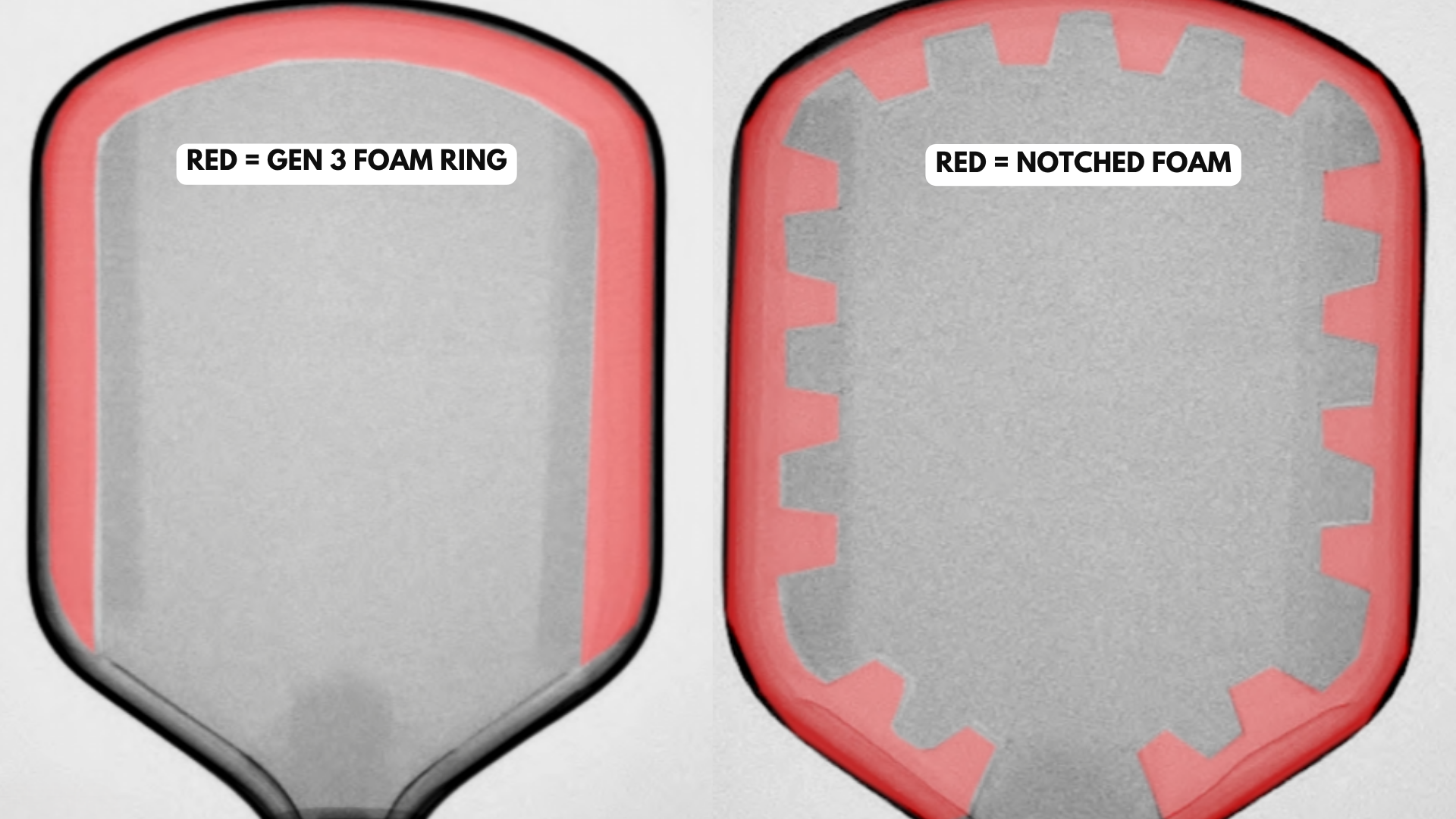Honolulu J2NF & J2FC+ Review
Save 10% at checkout with code: PBSTUDIO
The new Honolulu foam core paddles are In my opinion, some of the most well-rounded paddles money can buy right now.
Honolulu is notorious for throwing everything at the wall and seeing what sticks, when it comes to paddle releases, and I think this one is going to land.
I’ve tested all four new models, and while they all perform similarly, I’ll be breaking down which ones I would recommend, how they play, and what to look out for before buying.
If you’ve been trying to figure out which one to get, hopefully this review makes it easier for you.
Table Of Contents
Model Name Decoder — What all the letters in the name mean
Construction — How the builds differ
Specs, Feel, and Break-in — Stats and what stood out
Weight Setups — The two tape setups I tested
Consistencies Between All Model
NF vs FC+ vs The Rest — Which Models I’d Recommend
How It Compares to the CRBN TruFoam
Final Thoughts — Should you buy? If so, which one?
Model Name Decoder (What All the Letters Actually Mean)
If you’ve looked at Honolulu’s paddle names and thought, “What does any of this mean?” you’re not alone. It’s a little confusing.
Here’s a quick breakdown to make sense of it:
J2 = The shape. J2 is hybrid, J7 is elongated, J3 is widebody.
NF = Notched Foam. This refers to their newer core design.
FC = Foam Core
K or T = The face material. K is Kevlar, T is polyester (they call it titanium, but it’s not actually titanium).
+ = Gen 3-style foam ring around the edges, of the core
So when you see:
J2NF → Hybrid shape and notched foam core
J2NFK → Same setup, but with a Kevlar face
J2FC+ → Hybrid shape, foam core, Gen 3-style foam ring.
Most players don’t need to get too deep into this. But if you were scratching your head reading through the product list, now you know what’s what.
Still, I’ll say it. Honolulu would make things way easier if they trimmed the lineup and used simpler names.
Construction
There are really just two core structures happening in this release.
Notched Foam (NF series)
These use a full EPP foam core with a locking foam ring around the edges. The edges interlock like little gears. The NF also features a carbon fiber, fiberglass, carbon fiber face layup. FIberglass traditionally adds more pop to paddles.FC+
This uses the more common Gen 3-style foam ring, and a triple layer carbon fiber face setup.
When testing them, I expected them to feel more different than they actually did. The J2NF plays a bit stiffer and feels more reactive in fast exchanges (hands battles, counters, etc.). Thanks to the fiberglass.
The J2FC+ feels slightly softer at the net and a touch more forgiving on resets. But even in blind testing, the difference was small. I had to really pay attention to pick it up.
Unless you’re extremely dialed into paddle feedback, you probably won’t notice a big performance gap between the two. They are more similar than different.
Specs, Feel, and Break-in
Price: $195 retail, or $175 with code PBSTUDIO
Swing weight: Most units fell between 109 and 112
Twist weight: ~6.7
Static Weight:
NF: 8.08oz
FC+: 8.06oz
(weights of my units)
Handle length: Advertised as 5.5 inches, but feels closer to 5.25
Warranty: 1 year, which is good to see on a foam core paddle
Feel: If you use a two-handed backhand, that handle may feel short. The good news is they’re planning to release a longer handle version of the J2FC+ and J2NF in August.
Right out of the box, the paddles are very playable. You don’t have to add weight to make them feel good, but the shape and specs leave room to customize if you want.
Break-in: I didn’t notice any. My pre-production J2NF from June still plays like the production version. Consistency has been great.
Weight Setups I Tested
Similar to the SLK Era or 11six24 Power Series, these are very playable out of the box and it’ll just come down to personal preference on whether you want to make it play a little different or not.
And the specs on these allow for customizability without getting too heavy. Do keep in mind that weight between units do vary, so don’t be surprised if your paddle’s weight is a bit different.
I played around with two different lead tape setups:
3 grams near the head
This brought the swing weight from 107 up to 112. It gave the paddle better plow through and is the setup I ended up sticking with.
0.5 gram tungsten tape down both sides
This raised the swing weight from 110 to 113, but didn’t noticeably improve performance. The paddle is already stable, so boosting twist weight didn’t make much difference.
If you want more power, I’d focus on adding weight near the top corners. That helps with plow through and gives you a more aggressive swing without throwing off the balance too much.
What’s Consistent Across the Line
There are a lot of similarities between all four models. So before breaking them apart, here’s what you can expect no matter which one you pick:
Sweet Spot: Large, especially for a hybrid. I’d put it in the oversized category. If you’re used to elongated paddles, you might misjudge your strike zone at first. But for hybrid users, this is one of the better sweet spots I’ve felt.
Hand Speed: Really solid. These are easy to maneuver thanks to the low swing weights and balance points.
Power: Similar to something like the 11Six24 Power Series. Enough to swing freely, but not so hot that you lose control.
Spin: Excellent. All models tested over 2100 RPM. Honolulu paddles tend to come rougher than a lot of other brands. Whether that’s within legal limits is for USAP to decide.
Break-In: Similarly to my pre-production J2NF from June, still plays like the production version. Consistency has been great. I didn’t notice any break-in.
NF vs FC+ vs the Rest: What’s the Difference?
Let’s make this easy.
The J2NF feels a bit stiffer and more explosive, especially during fast hands exchanges.
The J2FC+ feels a little softer and easier to control up at the net.
That’s really the main difference. Both are stable, both offer good power, and both are easy to play with. It just comes down to feel.
Want more pop? Go with the J2NF
Want more control? Try the J2FC+
Just remember, the differences really are not that big. I think Honolulu releasing so many similar paddles is going to contribute to people being confused on which one they should pick, when ultimately they are all great and the biggest difference is the feel on ball contact.
Now for the other two:
NFK uses a Kevlar face, and the feel sits somewhere between the FC+ and NF. Which is to say, it isn’t as soft feeling as the FC+, but not as stiff as the NF.
NFT uses a polyester face. Slightly softer and more plush feeling than the FC+, but not by much.
Honestly, the NFK and NFT didn’t stand out. They play fine, but I don’t think they offer anything you can’t already get from the NF or FC+. If you’ve already used a J2K, or J2Ti and really liked how one of those played, then I would pick up the same variant of the notched foam models to make it simple.
If you're picking one up, I’d stick with J2NF or J2FC+. No need to overthink it.
How It Compares to the CRBN TruFoam
I’m throwing the CRBN2 TruFoam in here as a comparison becasue I’ve mained it for about 7 to 8 months, and up until now, it’s been one of my go-to foam paddles.
So when I started testing the J2NF, I wasn’t expecting it to stack up this well, but honestly, it does. It’s one of the first foam paddles that made me stop and think, “this might actually be better than the CRBN.”
Now, if you already own a weighted TruFoam and like how it plays, I wouldn’t feel any pressure to switch. It’s still a great paddle. But if you’re thinking about upgrading or trying something new, the J2NF is definitely worth a look.
What the J2NF Does Better
Here’s where I think the J2NF edges out the TruFoam:
Lower swing weight
Better performance right out of the box
Bigger and more forgiving sweet spot
More consistent feel across the face
The sweet spot, in particular, stood out to me. The TruFoam has a decent one, but there are small dead zones unless you weight it up. Even with lead tape, I still think the J2NF has the edge. It uses a full fiberglass layer across the face, not just a patch, so I didn’t get that occasional surprise ball that flies long off the center like I sometimes did with the CRBN.
What the TruFoam Still Does Well
That said, the TruFoam has a few things going for it that some players might still prefer:
A bouncier, springier feel off the sweet spot
Softer feedback on contact, which some people like
More shape options, including elongated, widebody, and hybrid
The TruFoam also leans more toward an all-court paddle right out of the box. Not everyone needs more power, and if you’re looking for balance over pop, the Genesis still fills that role nicely.
So here’s my take. If you already have a TruFoam set up the way you like it, no need to rush out and replace it. But if you’re after something with a little more pop, a larger sweet spot, and cleaner performance stock, the J2NF is a very real upgrade.
Final Thoughts
The J2NF and J2FC+ are two of the best all-around paddles I’ve tested this year. They give you that rare combo of power, stability, and control without needing a bunch of setup or lead tape.
✅ Here’s Why They Stand Out:
Durability — Full foam core builds like this have held up better than most Gen 3-style paddles. Early signs look solid.
Great Right Out of the Box — No weight mods needed to get high-level performance. You can play it stock or customize later if you want.
Balanced Power — They sit in the lower end of the power spectrum. Enough to swing big, but still easy to control.
Price — At $175 with code PBSTUDIO, they’re priced well below other top-tier paddles pushing $250 and up.
❌ Who This Paddle Might Not Be For
Players who want an elongated shape — Right now it’s only available in the J2 hybrid Players chasing max power — If you’re looking for pure heat like a JOOLA Pro 4, this isn’t it.
Players who need a longer handle — The handle plays closer to 5.25 inches. A longer version is coming, but not available yet.
Tournament players in PPA events — These aren’t UPA certified as of now.
If none of those apply to you, this is one of the best value picks on the market.
I used the J2NF in a recent 5.0-plus moneyball and finished second. It felt great the entire time and is one of the few paddles I’m seriously considering as my main. Once I wrap up testing the CRBN TruFoam4 and Gearbox GX2 Power, I’ll make a final decision.
If you’re thinking about trying one, use PBSTUDIO at checkout to save 10%.
Hope this helped. Let me know if you have any questions.









